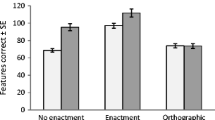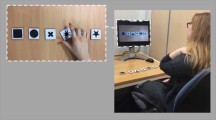Abstract
Novel naturalistic actions (NNAs) are multi-step, goal-directed actions involving the manipulation of objects that are unfamiliar to a person prior to instruction. Experiment 1 investigated the cognitive processes involved with encoding and performing NNAs by selectively interfering with attention during viewing or production of a NNA using the dual-task paradigm (n = 27, healthy adults). Consistent with the central findings from the dual-task memory literature, dividing attention at viewing caused a relatively greater disruptive effect on NNA performance than selectively interfering with attention during enactment. A follow-up experiment (n = 24, healthy adults) increased difficulty of memory retrieval by having participants verbally describe previously viewed NNAs while concurrently performing a secondary task, and it revealed no significant differences between the effects of dividing attention on the verbal description and physical construction of NNAs. The implications of our findings for the processes mediating encoding and enactment of naturalistic actions were presented. As well, the utility of a dynamic technique of inducing error types normally found in neurologically impaired populations was discussed.





Similar content being viewed by others
Notes
Fleiss and Cohen (1973) have demonstrated mathematically that the ICC is equivalent to weighted Kappa, and recommend its use in analyses with several nominal variables to be judged that behave more like ordinal variables. Conventionally, an ICC of 0.70 is considered acceptable inter-rater reliability in psychological research (more detailed guidelines dictated that 0.40–0.59 represents moderate inter-rater reliability, 0.60–0.79 substantial, and 0.80 outstanding; see Landis & Koch, 1977).
References
Baddeley, A. D. (1986). Working memory. Oxford: Oxford University Press.
Baddeley, A. D., Lewis, V., Eldridge, M., & Thomson, N. (1984). Attention and retrieval from long-term memory. Journal of Experimental Psychology: General, 113, 518–540.
Bekkering, H., Brass, M., Woschina, S., & Jacobs, A. M. (2005). Goal-directed imitation in patients with ideomotor apraxia. Cognitive Neuropsychology, 22, 419–432.
Botvinick, M., & Plaut, D. C. (2004). Doing without schema hierarchies: A recurrent connectionist approach to normal and impaired routine sequential action. Psychological Review, 111, 395–429.
Butterworth, G. (1990). On reconceptualizing sensori-motor coordination in dynamic system terms. In H. Bloch, & B. I. Bertenthal (Eds.), Sensory motor organization and development in infancy and early childhood (pp. 57–73). The Netherlands: Kluwer.
Buxbaum, L. J., Kyle, K. M., & Menon, R. (2005). On beyond mirror neurons: Internal representations subserving imitation and recognition of skilled objects-related actions in humans. Cognitive Brain Research, 25, 226–239.
Buxbaum, L. J., Schwartz, M. F., & Montgomery, M. W. (1998). Ideational apraxia and naturalistic action. Cognitive Neuropsychology, 15, 617–643.
Cooper, R. P., Schwartz, M. F., Yule, P., & Shallice, T. (2005). The simulation of action disorganization in complex activities of daily living. Cognitive Neuropsychology, 22, 959–1004.
Craik, F. I. M., Govoni, R., Naveh-Benjamin, M., & Anderson, N. D. (1996). The effects of divided attention on encoding and retrieval processes in human memory. Journal of Experimental Psychology: General, 125, 159–180.
Craik, F. I. M, Naveh-Benjamin, M., Ishaik, G., & Anderson, N. D. (2000). Divided attention during encoding and retrieval: Differential control effects? Journal of Experimental Psychology: Learning, Memory, and Cognition, 26, 1744–1749.
Creem, S. H., & Proffitt, D. R. (2001). Grasping objects by their handles: A necessary interaction between cognition and action. Journal of Experimental Psychology: Human Perception and Performance, 27, 218–228.
Decety, J., Grezes, J., Costes, N., Perani, D., Jeannerod, M., Procyk, E., et al. (1997). Brain activity during observation of actions: Influence of action content and subject’s strategy. Brain, 120, 1763–1777.
De Renzi, E., & Lucchelli, F. (1988). Ideational apraxia. Brain, 111, 1173–1185.
Dobbs, A. R., & Rule, B. G. (1989). Adult age differences in working memory. Psychology and Aging, 4, 500–503.
Engelkamp, J. (1998). Memory for actions. Hove: Psychology Press.
Fernandes, M. A., & Moscovitch, M. (2000). Divided attention and memory: Evidence of substantial interference effects at retrieval and encoding. Journal of Experimental Psychology: General, 129, 155–176.
Fleiss, J. L., & Cohen, J. (1973). The equivalence of weighted kappa and the intraclass correlation coefficient as measures of reliability. Educational and Psychological Measurement, 33, 613–619.
Giovannetti, T., Libon, D. J., Buxbaum, L. J., & Schwartz, M. F. (2002). Naturalistic action impairments in dementia. Neuropsychologia, 40, 1220–1232.
Gobet, F., Lane, P. C. R., Croker, S., Cheng, P. C.-H., Jones, G., Oliver, I., & Pine, J. M. (2001). Chunking mechanisms in human learning. Trends in Cognitive Sciences, 5, 236–243.
Hartmann, K., Goldenberg, G., Daumuller, M., & Hermsdorfer, J. (2005). It takes the whole brain to make a cup of coffee: The neuropsychology of naturalistic actions involving technical devices. Neuropsychologia, 43, 625–637.
Humphreys, G. W., & Forde, E. M. E. (1998). Disordered action schema and action disorganisation syndrome. Cognitive Neuropsychology, 15, 771–811.
Iacoboni, M., Woods, R. P., Bekkering, H., Mazziotta, J. C., & Rizzolatti, G. (1999). Cortical mechanisms of human interaction. Science, 286, 2526–2528.
Landis, J. R., & Koch, G. G. (1977). The measurement of observer agreement for categorical data. Biometrics, 33, 159–174.
Lindemann, O., Stenneken, P., van Schie, H. T., & Bekkering, H. (2006). Semantic activation in action planning. Journal of Experimental Psychology: Human Perception and Performance, 32, 633–643.
Luria, A. R. (1966). Higher cortical functions in man. London: Tavistock.
Moscovitch, M. (1992). Memory and working with memory: A component process model based on modules and central systems. Journal of Cognitive Neuroscience, 4, 257–267.
Moscovitch, M. (1994). Interference at retrieval from long-term memory: The influences of frontal and temporal lobes. Neuropsychology, 4, 525–534.
Naveh-Benjamin, M., Craik, F. I. M., Guez, J., & Dori, H. (1998). Effects of divided attention on encoding and retrieval processes in human memory: Further support for an asymmetry. Journal of Experimental Psychology: Learning, Memory, and Cognition, 24, 1091–1104.
Naveh-Benjamin, M., Craik, F. I. M., Guez, J., & Kreuger, S. (2005). Divided attention in younger and older adults: Effects of strategy and relatedness on memory performance and secondary task costs. Journal of Experimental Psychology: Learning, Memory, and Cognition, 31, 520–537.
Naveh-Benjamin, M., Kilb, A., & Fisher, T. (2006). Concurrent task effects on memory encoding and retrieval: Further support for an asymmetry. Memory and Cognition, 34, 90–101.
Newtson, D. (1973). Attribution and the unit of perception of ongoing behavior. Journal of Personality and Social Psychology, 28, 28–38.
Nyberg, L., Petersson, K. M., Nilsson, L-G., Sandblom, J., Aberg, C., & Ingvar, M. (2001). Reactivation of motor brain area during explicit memory for actions. Neuroimage, 14, 521–528.
Prinz, W. (1997). Perception and action planning. European Journal of Cognitive Psychology, 9, 129–154.
Rizzolatti, G., Fadiga, L., Gallese, V., & Fogassi, L. (1996). Premotor cortex and the recognition of motor actions. Cognitive Brain Research, 3, 131–141.
Rohrer, D., & Pashler, H. E. (2003). Concurrent task effects on memory retrieval. Psychonomic Bulletin & Review, 10, 96–103.
Rumiati, R. I., & Bekkering, H. (2003). To imitate or not to imitate: How the brain can do it, that is the question. Brain and Cognition, 53, 479–482.
Rumiati, R. I., & Tessari, A. (2002). Imitation of novel and well-known actions. Experimental Brain Research, 142, 425–433.
Rusted, J., & Sheppard, L. (2002). Action-based memory in Alzheimer’s Disease: A longitudinal look at tea making. Neurocase, 8, 111–126.
Schacter, D. L., & Tulving, E. (1994). What are the memory systems of 1994? In: D. L. Schacter, & E. Tulving (Eds.), Memory systems 1994 (pp. 1–35). Cambridge: MIT Press.
Schneider, W., Eschman, A., & Zuccolotta, A. (2002). E-prime user’s guide. Pittsburgh: Psychology Software Tools.
Schwartz, M. F. (2006). The cognitive neuropsychology of everyday action and planning. Cognitive Neuropsychology, 23, 202–221.
Schwartz, M. F., Buxbaum, L. J., Montgomery, M. W., Fitzpatrick-DeSalme, E., Hart, T., Ferraro, M., et al. (1999). Naturalistic action production following right hemisphere stroke. Neuropsychologia, 37, 51–56.
Schwartz, M. F., Montgomery, M. W., Buxbaum, L. J., Less, S. S., Carew, T. G., Coslett, H. B., et al. (1998). Naturalistic action impairment in closed head injury. Neuropsychologia, 12, 13–28.
Schwartz, M. F., Reed, E. S., Montgomery, M. W., Palmer, C., & Mayer, N. H. (1991). The qualitative description of action disorganization after brain damage: A case study. Cognitive Neuropsychology, 8, 381–414.
Shrout, P. E., & Fleiss, J. L. (1979). Intraclass correlations: Uses in assessing rater reliability. Psychological Bulletin, 86, 420–428.
Smith, E. E., & Jonides, J. (1999). Storage and executive processes in the frontal lobes. Science, 283, 1657–1661.
Troyer, A. K., & Craik, F. I. M. (2000). The effect of divided attention on memory for items and their context. Canadian Journal of Experimental Psychology, 54, 161–170.
Zacks, J. M., Tversky, B., & Iyer, G. (2001). Perceiving, remembering, and communicating structure in events. Journal of Experimental Psychology: General, 130, 29–58.
Zalla, T., Plassiart, C., Pillon, B., Grafman, J., & Sirigu, A. (2001). Action planning in a virtual context after prefrontal cortex damage. Neuropsychologia, 39, 759–770.
Zalla, T., Pradat-Diehl, P., & Sirigu, A. (2003). Perception of action boundaries in patients with frontal lobe damage. Neuropsychologia, 41, 1619–27.
Author information
Authors and Affiliations
Corresponding author
Additional information
David Gold’s research was supported in part by a Canadian Institute of Health Research Canada Graduate Scholarship Master’s Award, National Science and Engineering Research Council Doctoral Award, and an Ontario Graduate Scholarship Doctoral Award. Norman Park’s research was supported in part by the Heart and Stroke Foundation.
Appendix A
Appendix A
List of the primary steps required to perform one of the novel naturalistic actions
Bird feeder NNA
-
1.
Make a hole in the center of a styrofoam ball using a tapered stick.
-
2.
Enlarge the hole in the ball with a pencil.
-
3.
Take wire and thread button onto wire.
-
4.
Thread both ends of wire through the ball, and twist the wire at the top.
-
5.
Put an adequate amount of glue onto paper. Coat glue evenly on surface of ball.
-
6.
Roll ball in birdseed so that it covers entire surface of ball.
-
7.
Display birdfeeder properly by holding it by wire.
Rights and permissions
About this article
Cite this article
Gold, D.A., Park, N.W. The effects of dividing attention on the encoding and performance of novel naturalistic actions. Psychological Research 73, 336–349 (2009). https://doi.org/10.1007/s00426-008-0148-4
Received:
Accepted:
Published:
Issue Date:
DOI: https://doi.org/10.1007/s00426-008-0148-4




